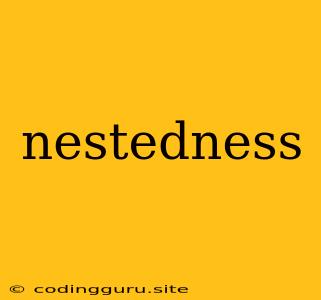Unveiling the Art of Nestedness: A Comprehensive Guide
Nestedness is a fundamental concept in various fields, from computer science and mathematics to biology and linguistics. It describes the hierarchical structure where elements are contained within other elements, forming a tree-like arrangement. Understanding nestedness is crucial for grasping complex systems and designing efficient solutions.
What is Nestedness?
Imagine a set of Russian dolls, each doll fitting inside the next larger one. This is a simple analogy for nestedness. In this structure, each doll represents a "level" of nesting, and the entire collection demonstrates a hierarchy.
In computer science, nestedness refers to the organization of code blocks or data structures. For instance, a loop within another loop creates a nested structure. In a programming language like Python, you can have a function definition within another function, demonstrating nested functions.
In mathematics, nestedness appears in set theory, where a set can be a member of another set. This leads to nested sets like {1, 2, {3, 4}, 5}, where the set {3, 4} is nested within the larger set.
In biology, nestedness describes the structure of ecological communities. For example, a food web can be viewed as a nested system, with different trophic levels nested within each other.
In linguistics, nestedness is observed in sentence structures, where clauses and phrases are embedded within each other. For instance, a sentence like "The dog that chased the cat that caught the mouse ran away" exhibits nested clauses.
Benefits of Nestedness
Nestedness offers several advantages across diverse applications:
- Organization: It provides a structured and hierarchical way to manage complex systems, making them easier to understand and navigate.
- Efficiency: Nested structures often facilitate efficient algorithms and data manipulation, as elements can be accessed and processed in a systematic manner.
- Modularity: Nestedness allows for the creation of modular components that can be reused and combined, promoting code reusability and reducing redundancy.
- Flexibility: Nested systems can adapt to changes and accommodate new elements without disrupting the overall structure.
Examples of Nestedness
1. Data Structures:
In programming, data structures like arrays and lists can be nested to represent complex relationships. Consider a list of students, each containing a nested list of their courses:
students = [
["Alice", ["Math", "Physics"]],
["Bob", ["Biology", "Chemistry"]],
["Charlie", ["History", "Literature"]]
]
This nested list structure allows you to easily access the courses of each student.
2. File Systems:
Operating systems like Linux and Windows use a hierarchical file system, where directories are nested within each other. This enables efficient organization and management of files and folders.
3. Web Development:
HTML, the language used for web pages, employs nested elements to create structured content. For example, a paragraph tag <p> can be nested within a div tag <div> to define a specific section on a web page.
4. JSON Data:
JSON (JavaScript Object Notation) is a popular format for exchanging data, and it heavily relies on nested structures. Objects within JSON can contain nested objects and arrays, representing complex data relationships.
Challenges of Nestedness
While nestedness provides significant benefits, it also comes with certain challenges:
- Complexity: Deeply nested structures can become complex and difficult to manage, leading to potential errors and reduced readability.
- Performance: Excessive nesting can impact performance, particularly in recursive algorithms or data processing tasks.
- Maintainability: As the nesting level increases, it becomes more challenging to modify or debug the system, as changes can ripple through nested components.
Tips for Effective Use of Nestedness
To leverage the benefits of nestedness while mitigating potential challenges, consider these tips:
- Keep nesting levels shallow: Aim for a reasonable depth of nesting, typically not exceeding 3-4 levels.
- Use meaningful names: Clearly label nested components to enhance readability and maintainability.
- Employ tools for visualization: Use visualization tools to help understand complex nested structures and identify potential issues.
- Consider alternatives: If nesting becomes overly complex, explore alternative data structures or approaches that might be more efficient.
Conclusion
Nestedness is a powerful concept that enables efficient organization and management of complex systems. By understanding the benefits and challenges associated with it, developers and practitioners can leverage its power effectively across various domains. From programming languages and data structures to ecological networks and sentence structures, nestedness plays a vital role in shaping how we understand and interact with the world around us.
